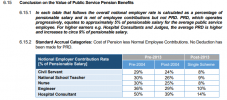I also think that something that needs to be considered when comparing pension benefits is the possibility for private sector workers to be made redundant and be paid a considerable lump sum. All public servants post 95 pay full A rate PRSI but will never have the possibility of being made redundant. This can be seen a huge advantage as redundancy can be catastrophic for someone who will struggle to get another job. However I have a number of friends who have been made redundant and have received quite considerable lump sums (more than I will be entitled to after my decades of PS service) and have secured another job within a number of months. I know the company themselves will fund some of this payment but they are also getting maximum benefit for their PRSI contributions.
Anyone getting a considerable lump sum is getting it from their employer not from PRSI.
Statutory redundancy is capped at 600e per week - 2 weeks per year + one week - even though PRSI is uncapped. If someone+employer is paying 4%+11% PRSI - over say 20 years at for example 80k that's around 240,000 in PRSI to get back 600x(20x2)+600 = 24600 in statutory.
600e has not been increased since 2005.
